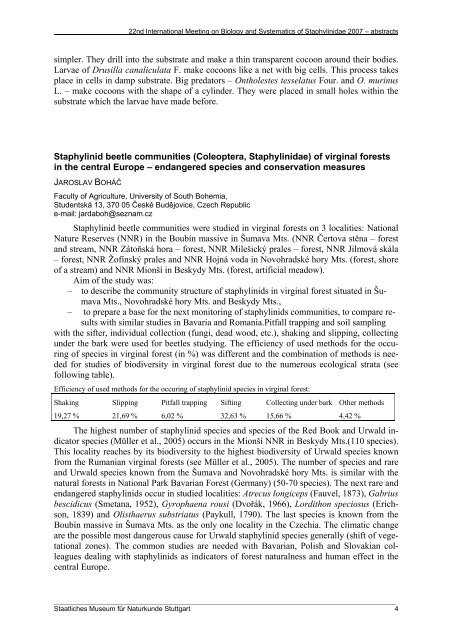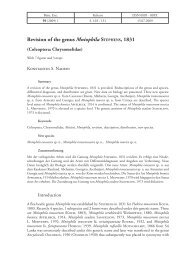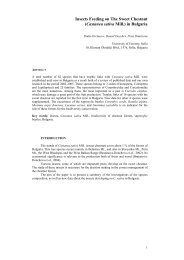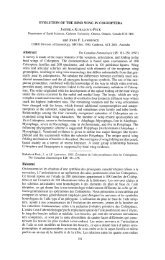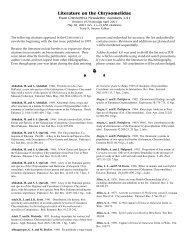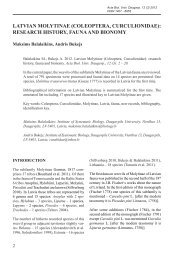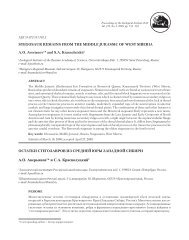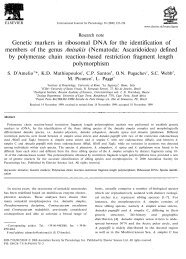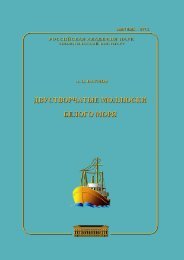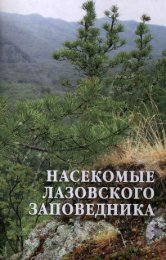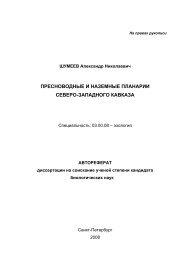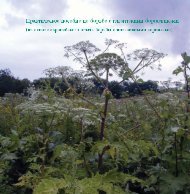International Meeting on Biology and Systematics of Staphylinidae
International Meeting on Biology and Systematics of Staphylinidae
International Meeting on Biology and Systematics of Staphylinidae
You also want an ePaper? Increase the reach of your titles
YUMPU automatically turns print PDFs into web optimized ePapers that Google loves.
22nd <str<strong>on</strong>g>Internati<strong>on</strong>al</str<strong>on</strong>g> <str<strong>on</strong>g>Meeting</str<strong>on</strong>g> <strong>on</strong> <strong>Biology</strong> <strong>and</strong> <strong>Systematics</strong> <strong>of</strong> <strong>Staphylinidae</strong> 2007 – abstracts<br />
simpler. They drill into the substrate <strong>and</strong> make a thin transparent coco<strong>on</strong> around their bodies.<br />
Larvae <strong>of</strong> Drusilla canaliculata F. make coco<strong>on</strong>s like a net with big cells. This process takes<br />
place in cells in damp substrate. Big predators – Ontholestes tesselatus Four. <strong>and</strong> O. murinus<br />
L. – make coco<strong>on</strong>s with the shape <strong>of</strong> a cylinder. They were placed in small holes within the<br />
substrate which the larvae have made before.<br />
Staphylinid beetle communities (Coleoptera, <strong>Staphylinidae</strong>) <strong>of</strong> virginal forests<br />
in the central Europe – endangered species <strong>and</strong> c<strong>on</strong>servati<strong>on</strong> measures<br />
JAROSLAV BOHÁČ<br />
Faculty <strong>of</strong> Agriculture, University <strong>of</strong> South Bohemia,<br />
Studentská 13, 370 05 České Budějovice, Czech Republic<br />
e-mail: jardaboh@seznam.cz<br />
Staphylinid beetle communities were studied in virginal forests <strong>on</strong> 3 localities: Nati<strong>on</strong>al<br />
Nature Reserves (NNR) in the Boubín massive in Šumava Mts. (NNR Čertova stěna – forest<br />
<strong>and</strong> stream, NNR Zátoňská hora – forest, NNR Milešický prales – forest, NNR Jilmová skála<br />
– forest, NNR Ž<strong>of</strong>ínský prales <strong>and</strong> NNR Hojná voda in Novohradské hory Mts. (forest, shore<br />
<strong>of</strong> a stream) <strong>and</strong> NNR Mi<strong>on</strong>ší in Beskydy Mts. (forest, artificial meadow).<br />
Aim <strong>of</strong> the study was:<br />
– to describe the community structure <strong>of</strong> staphylinids in virginal forest situated in Šumava<br />
Mts., Novohradské hory Mts. <strong>and</strong> Beskydy Mts.,<br />
– to prepare a base for the next m<strong>on</strong>itoring <strong>of</strong> staphylinids communities, to compare results<br />
with similar studies in Bavaria <strong>and</strong> Romania.Pitfall trapping <strong>and</strong> soil sampling<br />
with the sifter, individual collecti<strong>on</strong> (fungi, dead wood, etc.), shaking <strong>and</strong> slipping, collecting<br />
under the bark were used for beetles studying. The efficiency <strong>of</strong> used methods for the occuring<br />
<strong>of</strong> species in virginal forest (in %) was different <strong>and</strong> the combinati<strong>on</strong> <strong>of</strong> methods is needed<br />
for studies <strong>of</strong> biodiversity in virginal forest due to the numerous ecological strata (see<br />
following table).<br />
Efficiency <strong>of</strong> used methods for the occuring <strong>of</strong> staphylinid species in virginal forest:<br />
Shaking Slipping Pitfall trapping Sifting Collecting under bark Other methods<br />
19,27 % 21,69 % 6,02 % 32,63 % 15,66 % 4,42 %<br />
The highest number <strong>of</strong> staphylinid species <strong>and</strong> species <strong>of</strong> the Red Book <strong>and</strong> Urwald indicator<br />
species (Müller et al., 2005) occurs in the Mi<strong>on</strong>ší NNR in Beskydy Mts.(110 species).<br />
This locality reaches by its biodiversity to the highest biodiversity <strong>of</strong> Urwald species known<br />
from the Rumanian virginal forests (see Müller et al., 2005). The number <strong>of</strong> species <strong>and</strong> rare<br />
<strong>and</strong> Urwald species known from the Šumava <strong>and</strong> Novohradské hory Mts. is similar with the<br />
natural forests in Nati<strong>on</strong>al Park Bavarian Forest (Germany) (50-70 species). The next rare <strong>and</strong><br />
endangered staphylinids occur in studied localities: Atrecus l<strong>on</strong>giceps (Fauvel, 1873), Gabrius<br />
bescidicus (Smetana, 1952), Gyrophaena rousi (Dvořák, 1966), Lordith<strong>on</strong> speciosus (Erichs<strong>on</strong>,<br />
1839) <strong>and</strong> Olisthaerus substriatus (Paykull, 1790). The last species is known from the<br />
Boubín massive in Šumava Mts. as the <strong>on</strong>ly <strong>on</strong>e locality in the Czechia. The climatic change<br />
are the possible most dangerous cause for Urwald staphylinid species generally (shift <strong>of</strong> vegetati<strong>on</strong>al<br />
z<strong>on</strong>es). The comm<strong>on</strong> studies are needed with Bavarian, Polish <strong>and</strong> Slovakian colleagues<br />
dealing with staphylinids as indicators <strong>of</strong> forest naturalness <strong>and</strong> human effect in the<br />
central Europe.<br />
__________________________________________________________________________________________<br />
Staatliches Museum für Naturkunde Stuttgart 4


